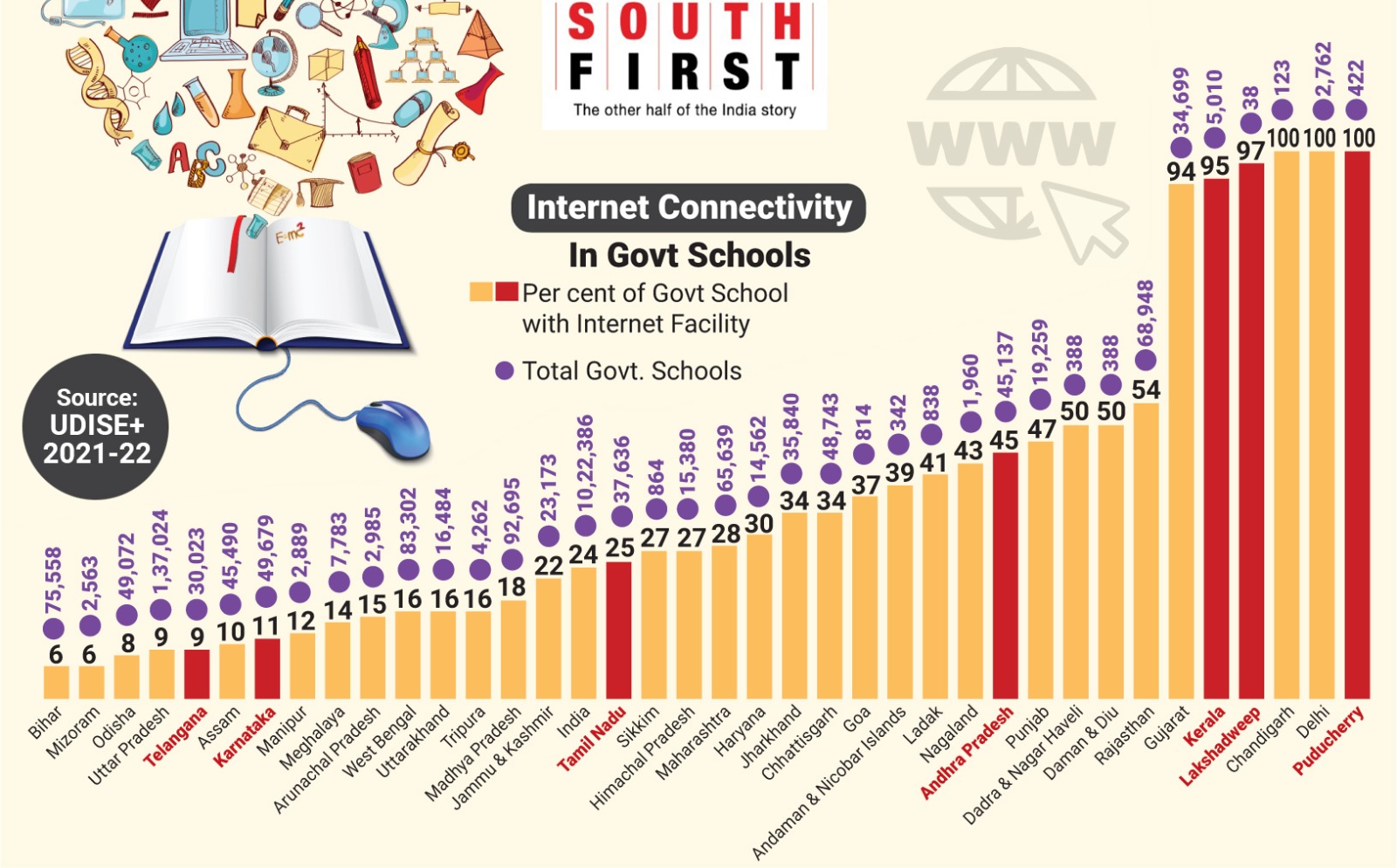As per an expert, internet facility is "very aspirational" in government schools several of which still lacks proper electricity facility.

Internet connectivity in government schools across India.
In the field of education, we are in Age of the Internet, with smart schools and connected classrooms fast becoming the norm. But a vast majority of the government schools across India are missing out.
This, at a time the Supreme Court has recognised the Right to the Internet as an integral part of the Right to Education (Article 21A) and the Right to Privacy (Article 21) of the Indian Constitution.
The stark reality is that of the over 10 lakh government schools in the country, only two lakh — about 20 percent — have internet facilities, according to data shared by Minister of State for Education Subhas Sarkar in the Lok Sabha earlier this week.
The minister was replying to a question asked by the Tamil Nadu DMK Member of Parliament, DNV Senthilkumar.
In the southern states, which have over 1.67 lakh government schools, only one in every four — 25.3 percent or 42,423 — have an internet connection.
But the average does not reveal the skew among the five southern states.
Of the total 30,023 government schools in Telangana, only 2,772 government schools (9.23 percent) have internet facilities.
This means just about one in 10 government schools have internet in a state that boasts of being one of the leading IT hubs of India.
“Very few government schools have computer labs as there are no funds to maintain them. And there is no computer teacher in any of the schools,” Thoutam Niharika, a math teacher at the Zilla Parishad High School (ZPHS) at Kamareddi Gudem in Warangal, told South First.
“If a headmaster or headmistress wants, they can purchase internet data and connection; but as it is not mandatory, few of them just claim the grant amount,” she added.
“When we have to, we use internet of our mobile phones to show students something online or when we have to fill data.”
Telangana is followed by Karnataka, whose capital Bengaluru is known as the Silicon Valley of India for its high-tech industry.
Only a little over 10 percent of the state’s government schools (5,308 out of 49,679 schools) are equipped with the internet.
Next in line is Tamil Nadu, where students of only one out of every four — 9,292 out of 37,636 — government schools have internet access.
In Andhra Pradesh, out of 45,137 total government schools, 20,313 have internet facilities (a healthy 45 percent).
The star of the South, however, is Kerala, where nearly 95 percent of government schools (4,738 of 5,010 schools) have internet facilities.
Speaking to South First, Varsha Bhargavi, national convener of the Telangana-based All India Child Rights Protection Forum (AICRPF) noted that lack of power in the state’s government schools was a bigger problem than internet facilities.
“Internet facility is very aspirational for many government schools in Telangana, where there is no electricity. In some schools, they have computers and not electricity, and vice-versa. School staff are also not trained to use computers, forget about imparting computer education. As every bit of data and report is digital now, most school teachers in Telangana use personal computers or mobile phones,” she claimed.
Bhargavi, who was also a state Resource Centre coordinator under the Union government’s erstwhile National Child Labour Project (NCLP), also explained how the introduction of the internet would help children and even schools.
“If the minutes of a school’s meetings are filed online, it would throw light on what the school lacks or aspires to have,” she said.
And pointing to a “digital divide” between children of government and private schools, she said: “I am not saying that internet will mean that government school children will start performing brilliantly overnight, but one needs to have basic access to a computer and internet so that students can get familiar with them,” Bhargavi said.
Bhargavi added that though the RTE says many good things, its norms are often flouted, especially after the pandemic.
“As we know, many children did not even have digital devices to check the syllabus. So it was sent to the social media groups of parents and was a one-way communication.”
The lack of internet facilities is a pan-India problem, with some states faring better than others. (See graph)
Among the worst performers are: Uttar Pradesh (only 12,074 out of 1,37,024 schools have internet; 8.81 percent), Bihar (4,421 out of 75,558 schools; 5.85 percent), Odisha (3,970 out of 49,072 schools; 8.09 percent), Madhya Pradesh (16,469 out of 92,695 schools; 17.77 percent), Maharashtra (18,450 out of 65,639 schools; 28.25 percent), Jammu & Kashmir (5,169 out of 65,639 schools; 22.31 percent) and West Bengal (12,918 out of 83,302 schools; 15.51 percent).
Meanwhile, government schools in three Union Territories — Delhi (2,762 schools), Chandigarh (123) and Puducherry (422) — have 100 percent internet facilities.

Apr 23, 2024

Apr 22, 2024

Apr 22, 2024

Apr 21, 2024

Apr 21, 2024